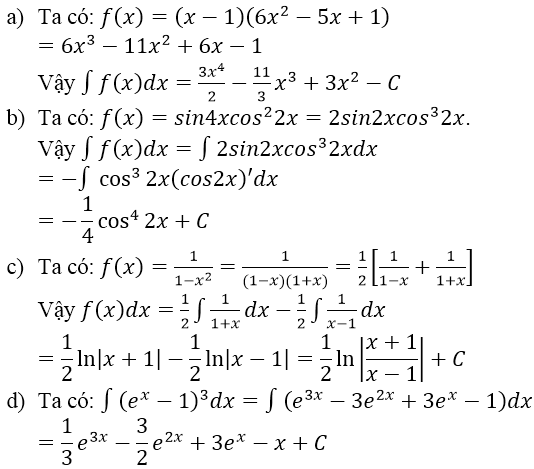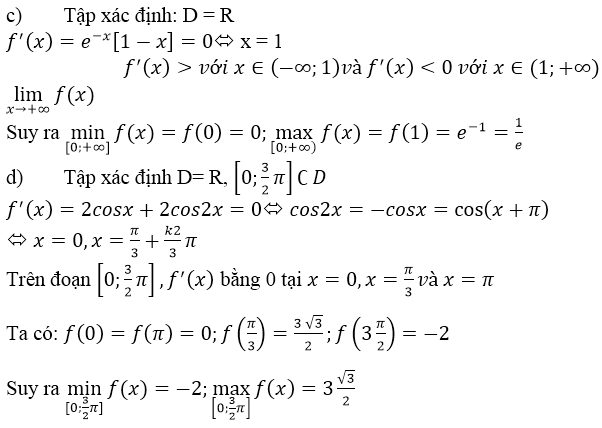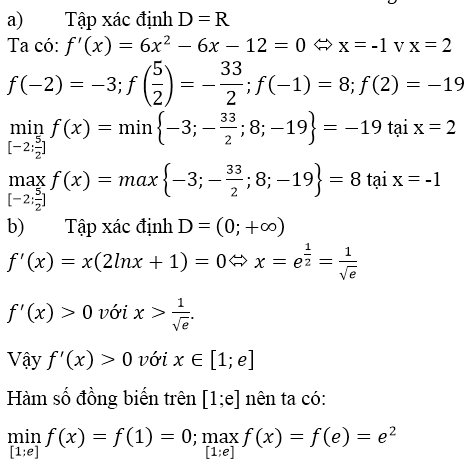Hãy nhập câu hỏi của bạn vào đây, nếu là tài khoản VIP, bạn sẽ được ưu tiên trả lời.

Để kiểm tra một hàm F(x) có phải là một nguyên hàm của f(x) không thì ta chỉ cần kiểm tra F'(x) có bằng f(x) không?
a) \(F\left(x\right)\) là hằng số nên \(F'\left(x\right)=0\ne f\left(x\right)\)
b) \(G'\left(x\right)=2.\dfrac{1}{2}.\dfrac{1}{\cos^2x}=1+\tan^2x\)
c) \(H'\left(x\right)=\dfrac{\cos x}{1+\sin x}\)
d) \(K'\left(x\right)=-2.\dfrac{-\left(\dfrac{1}{2}.\dfrac{1}{\cos^2\dfrac{x}{2}}\right)}{\left(1+\tan\dfrac{x}{2}\right)^2}=\dfrac{\dfrac{1}{\cos^2\dfrac{x}{2}}}{\left(\dfrac{\cos\dfrac{x}{2}+\sin\dfrac{x}{2}}{\cos\dfrac{x}{2}}\right)^2}\)
\(=\dfrac{1}{\left(\cos\dfrac{x}{2}+\sin\dfrac{x}{2}\right)^2}=\dfrac{1}{1+2\cos\dfrac{x}{2}\sin\dfrac{x}{2}}\)
\(=\dfrac{1}{1+\sin x}\)
Vậy hàm số K(x) là một nguyên hàm của f(x).

a) Điều kiện x>0. Thực hiện chia tử cho mẫu ta được:
f(x) = =
=
∫f(x)dx = ∫()dx =
+C
b) Ta có f(x) = =
-e-x
; do đó nguyên hàm của f(x) là:
F(x)= =
=
+ C
c) Ta có f(x) =
hoặc f(x) =
Do đó nguyên hàm của f(x) là F(x)= -2cot2x + C
d) Áp dụng công thức biến tích thành tổng:
f(x) =sin5xcos3x = (sin8x +sin2x).
Vậy nguyên hàm của hàm số f(x) là F(x) = -(
cos8x + cos2x) +C
e) ta có
vậy nguyên hàm của hàm số f(x) là F(x) = tanx - x + C
g) Ta có ∫e3-2xdx= -∫e3-2xd(3-2x)= -
e3-2x +C
h) Ta có :
= =

a)
Đặt \(u=\sqrt{x-3}\Rightarrow x=u^2+3\)
\(I_1=\int (2x-3)\sqrt{x-3}dx=\int (2u^2+3)ud(u^2+3)=2\int (2u^2+3)u^2du\)
\(\Leftrightarrow I_1=4\int u^4du+6\int u^2du=\frac{4u^5}{5}+2u^3+c\)
b)
\(I_2=\int \frac{xdx}{\sqrt{(x^2+1)^3}}=\frac{1}{2}\int \frac{d(x^2+1)}{\sqrt{(x^2+1)^2}}\)
Đặt \(u=\sqrt{x^2+1}\). Khi đó:
\(I_2=\frac{1}{2}\int \frac{d(u^2)}{u^3}=\int \frac{udu}{u^3}=\int \frac{du}{u^2}=\frac{-1}{u}+c\)
c)
\(I_3=\int \frac{e^xdx}{e^x+e^{-x}}=\int \frac{e^{2x}dx}{e^{2x}+1}=\frac{1}{2}\int\frac{d(e^{2x}+1)}{e^{2x}+1}\)
\(\Leftrightarrow I_3=\frac{1}{3}\ln |e^{2x}+1|+c=\frac{1}{2}\ln|u|+c\)
d)
\(I_4=\int \frac{dx}{\sin x-\sin a}=\int \frac{dx}{2\cos \left ( \frac{x+a}{2} \right )\sin \left ( \frac{x-a}{2} \right )}\)
\(\Leftrightarrow I_4=\frac{1}{\cos a}\int \frac{\cos \left ( \frac{x+a}{2}-\frac{x-a}{2} \right )dx}{2\cos \left ( \frac{x+a}{2} \right )\sin \left ( \frac{x-a}{2} \right )}=\frac{1}{\cos a}\int \frac{\cos \left ( \frac{x-a}{2} \right )dx}{2\sin \left ( \frac{x-a}{2} \right )}+\frac{1}{\cos a}\int \frac{\sin \left ( \frac{x+a}{2} \right )dx}{2\cos \left ( \frac{x+a}{2} \right )}\)
\(\Leftrightarrow I_4=\frac{1}{\cos a}\left ( \ln |\sin \frac{x-a}{2}|-\ln |\cos \frac{x+a}{2}| \right )+c\)
e)
Đặt \(t=\sqrt{x}\Rightarrow x=t^2\)
\(I_5=\int t\sin td(t^2)=2\int t^2\sin tdt\)
Đặt \(\left\{\begin{matrix} u=t^2\\ dv=\sin tdt\end{matrix}\right.\Rightarrow \left\{\begin{matrix} du=2tdt\\ v=-\cos t\end{matrix}\right.\)
\(\Rightarrow I_5=-2t^2\cos t+4\int t\cos tdt\)
Tiếp tục nguyên hàm từng phần \(\Rightarrow \int t\cos tdt=t\sin t+\cos t+c\)
\(\Rightarrow I_5=-2t^2\cos t+4t\sin t+4\cos t+c\)

a) f(x) = 2x3 – 3x2 – 12x + 1 ⇒ f’(x) = 6x2 – 6x – 12
f’(x) = 0 ⇔ x ∈ {-1, 2}
So sánh các giá trị:
f(x) = -3; f(-1) = 8;
f(2) = -19, f(52)=−332f(52)=−332
Suy ra:
maxx∈[−2,52]f(x)=f(−1)=8minx∈[−2,52]f(x)=f(2)=−19maxx∈[−2,52]f(x)=f(−1)=8minx∈[−2,52]f(x)=f(2)=−19
b) f(x) = x2 lnx ⇒ f’(x)= 2xlnx + x > 0, ∀ x ∈ [1, e] nên f(x) đồng biến.
Do đó:
maxx∈[1,e]f(x)=f(e)=e2minx∈[1,e]f(x)=f(1)=0maxx∈[1,e]f(x)=f(e)=e2minx∈[1,e]f(x)=f(1)=0
c) f(x) = f(x) = xe-x ⇒ f’(x)= e-x – xe-x = (1 – x)e-x nên:
f’(x) = 0 ⇔ x = 1, f’(x) > 0, ∀x ∈ (0, 1) và f’(x) < 0, ∀x ∈ (1, +∞)
nên:
maxx∈[0,+∞)f(x)=f(1)=1emaxx∈[0,+∞)f(x)=f(1)=1e
Ngoài ra f(x) = xe-x > 0, ∀ x ∈ (0, +∞) và f(0) = 0 suy ra
maxx∈[0,+∞)f(x)=f(0)=0maxx∈[0,+∞)f(x)=f(0)=0
d) f(x) = 2sinx + sin2x ⇒ f’(x)= 2cosx + 2cos2x
f’(x) = 0 ⇔ cos 2x = -cosx ⇔ 2x = ± (π – x) + k2π
⇔ x∈{−π+k2π;π3+k2π3}x∈{−π+k2π;π3+k2π3}
Trong khoảng [0,3π2][0,3π2] , phương trình f’(x) = 0 chỉ có hai nghiệm là x1=π3;x2=πx1=π3;x2=π
So sánh bốn giá trị : f(0) = 0; f(π3)=3√32;f(π)=0;f(3π2)=−2f(π3)=332;f(π)=0;f(3π2)=−2
Suy ra:
maxx∈[0,3π2]f(x)=f(π3)=3√32minx∈[0,3π2]f(x)=f(3π2)=−2





